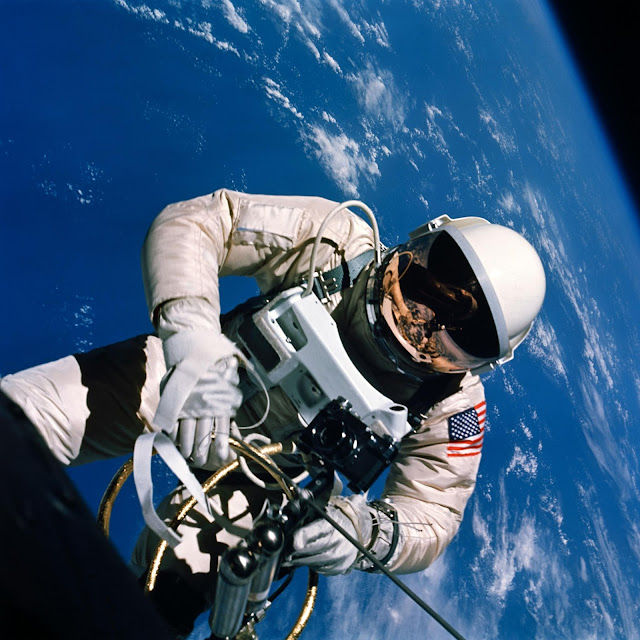This week sees the 50th anniversary of the first Moon landing by Apollo 11 (on 20th July 1969) and the first walk by Neil Armstrong the next day. Those of my age will have vivid memories of those events, but it's otherwise hard to find a direct tangible link to the Moon landing. However, there is one object that was used by the astronauts that we can all have a part of; their Omega Speedmaster Professional watches.
 |
| Buzz Aldrin on the Moon. His Omega Speedmaster can be seen on his right wrist. Amstrong's reflection can be seen in Aldrin's visor. Armstrong took the photos so there are no good quality images of him on the surface. |
On and off over the years I've enjoyed collecting vintage wristwatches. The watch that started this enthusiasm was the Omega Speedmaster Professional. The reason was simple: I could wear a watch identical to those worn on the Moon and by many astronauts and cosmonauts. Tool watches, made and used for a purpose, have to be robust, legible and minimally designed - all, for me, highly desirable qualities.
 |
| Omega Speedmasters on Armstrong's wrist at pre-launch breakfast, a geology field trip and with Buzz Aldrin's suit |
NASA and the Omega Speedmaster
The Speedmaster was NASA's official watch because it was robust and accurate. It was selected and purchased initially from a local watch shop and Omega themselves were not involved - so the watches used were off the peg, standard models.
 |
| Omega Speedmaster watches from the sixties (left) and now (right) as worn in the film First Man. The differences are hard to see & are mainly internal |
Within its rapidly accelerating space programme in 1964, NASA had gone in search of a wristwatch that it could qualify for its manned missions. Many brands submitted their timepieces for the punishing tests, but only the OMEGA Speedmaster survived. As a result, it was declared “Flight Qualified for all Manned Space Missions” on the 1st of March, 1965.
 |
| Buzz Aldrin wears his Omega Speedmaster in the command module of Apollo 11 |
Omega became the only official supplier of watches for NASA’s Human Space Flight Program. It was used throughout the final Mercury Missions and the Gemini, Apollo, Skylab and Apollo-Soyuz programs.
The Speedmaster Professional has since gone through many guises, but the basic mechanical model (it has appeared in quartz form) is essentially unchanged in outward appearance since the sixties. The original beautiful calibre 321 movement was replaced in the late sixties by the easier to manufacture cal. 861 and later 1861 (the modern variation) and this is still used in the watch available today. All these movements are hand-wound so need winding daily - not being automatic adds to their robustness.
Omega earlier this year announced the return of the cal. 321 and it has been used in the gold limited edition of the Speedmaster for the 50th anniversary of Apollo 11.
Omega earlier this year announced the return of the cal. 321 and it has been used in the gold limited edition of the Speedmaster for the 50th anniversary of Apollo 11.
 |
| Ed White wears an Omega Speedmaster for the US's first space walk on Gemini IV on 3rd June 1965 |
The Speedmaster Pro is still worn in space, until recently on the Shuttle and on ISS. It's even been used for EVAs (extra-vehicular activity) where its mechanical robustness and simplicity gives it the edge over its battery-powered cousins (see above: Ed White's first US EVA in June 1965).
 |
| Omega advertising c.1968 |
Buying an Omega Speedmaster Professional
The question here is, new or old?
If you're looking for a vintage cal. 321 vintage watch, like those worn in the early days of space flight, I urge caution. Over the years these have been repaired, serviced and had parts replaced. The best investment is one that has its original parts and has been kept regularly serviced. You will need reliable and expert advice when choosing. Budget from £7,000 and much more for a 1960s model in good condition. A good one will be a cast-iron investment.
You may be be reluctant to wear such collectible watch on a daily basis. As an alternative look for a later cal. 861 or a used modern example where you can spend from around £2000. This will provide a watch that you can wear regularly without worrying too much about it.
The Speedmaster Pro is a reliable and robust timekeeper; that's why NASA chose it, so wear it as it was intended; a tool watch to be bashed around and used well; but remember it wasn't designed to be very water resistant, so I wouldn't wear even a new one for swimming or in the shower.
Budget additionally for a service every few years; this will cost several hundred pounds, but it's important to look after a complicated chronograph movement.
A brand new Omega Speedmaster Pro can be bought in its basic form from around £3800 - see Omega's website for more information. Omega often bring out special editions such as the limited edition gold and steel 50th Anniversary Apollo 11 watches. These are eagerly snapped up by collectors and those looking for an investment. If you're not in one of those categories I suggest you look for a basic model or a used or vintage example of the models actually used in space (cal. 321 or 861).
 |
| Cosmonaut Elena Serova wears a mechanical Omega Speedmaster Pro (on left arm) and quartz Speedmaster X-33 (right arm) on a flight to the International Space Station in 2014 |
This is an unsponsored post.
